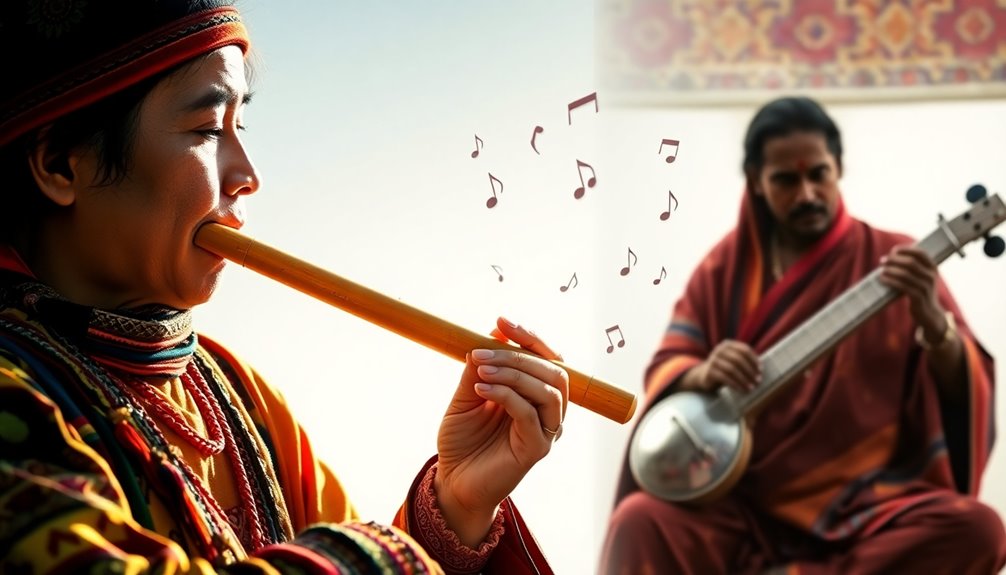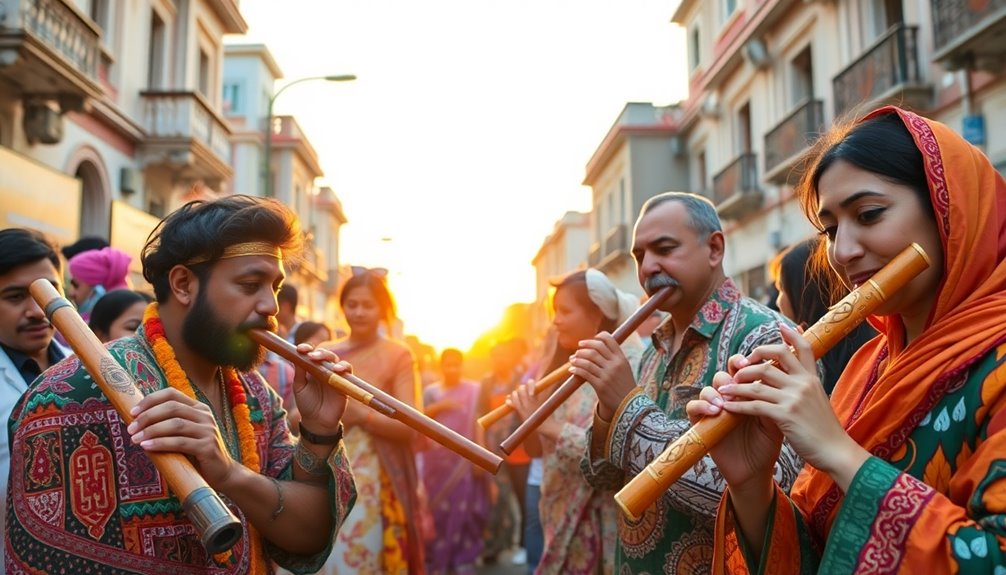The cultural impact on flute music genres is profound, intertwining historical narratives and regional traditions. Each culture brings its own significance to the flute, whether in ancient rituals or modern compositions. For instance, Native American flutes connect deeply with nature and spirituality, while Andean bamboo flutes echo communal identity. Folk traditions enrich the flute's repertoire, allowing personal expression through improvisation. As cultural exchanges continue, they shape new styles, merging influences to create innovative sounds. Understanding these dynamics reveals how contemporary flutists reflect varied heritages, pushing musical boundaries and connecting communities worldwide. Exploring these connections opens new avenues of insight.
Key Takeaways
- Flute music reflects cultural narratives, preserving community stories and identities across various regions and traditions.
- Diverse regional flutes, such as the bansuri and dizi, embody unique cultural sounds and techniques, influencing genre characteristics.
- Spiritual and religious practices shape flute music's purpose, linking melodies to healing, rituals, and collective identity among practitioners.
- Iconic flutists blend cultural influences, promoting genre development and community engagement through their unique interpretations and performances.
- The fusion of traditional and contemporary styles in flute music reflects broader cultural dynamics, paving the way for innovative musical expression.
Historical Origins of Flute Music

The historical origins of flute music reveal a rich tapestry woven through various cultures and epochs. You'll find that ancient civilizations across the globe, from the Egyptians to the Chinese, embraced the flute not merely as an instrument, but as a vessel of cultural symbolism.
In ancient Egypt, flutes were often associated with spiritual rituals, believed to connect the earthly domain to the divine. The mesmerizing sounds of the flute played a pivotal role in ceremonies, reflecting a society that valued music as a form of communication with the gods.
As you explore deeper, the significance of the flute transcends geography. In the Andes, indigenous cultures utilized bamboo flutes, crafting melodies that echoed the rhythms of nature and life itself. This connection to the environment illustrates how flute music served as a narrative device, telling stories of love, loss, and celebration.
Each note held meaning, solidifying the flute's role in communal identity. Moreover, you can appreciate how these ancient practices continue to resonate today. The cultural symbolism inherent in flute music fosters a sense of belonging, linking modern musicians to their historical counterparts. The diverse types of flutes, such as the Western Concert Flute, highlight the instrument's evolution and adaptability across different musical genres.
Regional Variations in Flute Genres

Flute genres across different regions showcase a fascinating interplay of cultural influences and musical traditions. When you explore African flutes, you'll discover an array of styles and sounds, often embodying the rhythms and stories of diverse communities. These instruments, such as the wooden bansuri or the end-blown flute, are integral to ceremonies and celebrations, reflecting deep cultural roots.
In contrast, Native American flutes provide a hauntingly beautiful sound that resonates with nature and spirituality. Each note seems to tell a story, emphasizing the connection between the environment and the musician. You might find that these flutes serve both as instruments of mourning and celebration, illustrating their multifunctional role in local traditions.
Traveling to Asia, you'll encounter bamboo flutes that vary greatly across countries. In China, the dizi offers a bright, lively sound, while India's bansuri introduces intricate melodies that are essential to classical music forms.
European classical music, with its structured compositions, employs the flute in orchestras, adding layers of sophistication and elegance. Latin American genres often incorporate flutes to create vibrant, rhythmic patterns, while Middle Eastern music showcases the nay, a wooden flute that enriches the melodic tapestry with its rich timbre.
Contemporary fusion genres blend these regional styles, allowing jazz improvisation to emerge, creating a space where traditional sounds meet modern innovation. This rich tapestry of flute genres invites you to appreciate the global diversity and shared humanity expressed through music. The flute family includes various instruments like the concert flute, piccolo, and alto flute, each contributing their unique voices to these diverse genres.
Influence of Folk Traditions

Across cultures, folk traditions have profoundly shaped flute music, infusing it with unique characteristics that reflect the narratives and identities of communities. When you investigate these traditions, you'll discover how folk melodies serve as the backbone of various flute genres, telling stories of love, struggle, and celebration. These melodies often stem from oral traditions, passed down through generations, making them an essential part of cultural heritage.
In many regions, traditional instruments, including the flute, aren't just musical tools but also symbols of cultural pride. For instance, the bamboo flute in Asian folk music or the Native American wooden flute both evoke deep connections to the land and its people. Each note played on these instruments carries the weight of history, resonating with the collective memory of a community.
Moreover, the improvisational nature of folk music allows you to engage with these traditions in a personal way. When you listen to or play folk melodies, you become part of a larger narrative, one that bridges the past with the present. This participatory aspect fosters a sense of belonging, as individuals come together to celebrate their cultural roots through music. The material quality of flutes, such as those made from cedar, further enhances the sound and connection to these rich traditions.
Ultimately, the influence of folk traditions on flute music creates a rich tapestry that invites you to appreciate the diverse expressions of human experience. As you investigate deeper into these genres, you'll find not only the artistry of the flute but also a profound connection to the stories that shape our world.
Role of Religion and Spirituality

Within various cultures, the role of religion and spirituality has greatly influenced the development and expression of flute music genres. You'll find that many flute traditions are deeply rooted in spiritual symbolism, serving as a bridge between the material and the sacred. For instance, in Native American cultures, the flute is often employed in healing ceremonies, where its melodic tones are believed to connect the physical domain with spiritual entities. This highlights the flute's role not just as an instrument, but as a conduit for spiritual expression.
In other cultures, such as those in the Andes, flutes are integral to ritualistic practices. The sounds produced during these ceremonies aren't merely for entertainment; they're imbued with meaning, intended to invoke deities or honor ancestors. Here, the flute becomes a voice that transcends the mundane, creating a sacred soundscape that fosters community and belonging.
Moreover, as you explore deeper into these traditions, you'll notice that the melodies often reflect religious narratives or spiritual journeys, reinforcing a collective identity among practitioners. Each note you hear carries the weight of cultural heritage, echoing the beliefs and values of those who play and listen. In many orchestral settings, the Western concert flute is recognized for its versatility and ability to convey deep emotional narratives, amplifying its spiritual significance.
This sacred aspect of flute music not only enriches the listener's experience but also strengthens the communal bonds that are essential for cultural continuity. Ultimately, the interplay between flute music and spirituality reveals a profound connection that speaks to our shared human experience.
Impact of Cultural Exchange

Cultural exchange has considerably shaped the evolution of flute music genres, leading to a rich tapestry of styles and techniques that reflect diverse influences. As you explore the world of flute music, you'll notice how cultural fusion manifests through various traditions. The flute, a versatile instrument, has adapted to numerous musical contexts, from the intricate rhythms of Indian classical music to the spirited melodies of Irish folk tunes.
When musicians from different backgrounds collaborate, they create unique soundscapes that transcend geographical boundaries. This musical collaboration not only enriches the flute repertoire but also fosters a sense of belonging among audiences and performers alike. You might find that the blending of styles encourages a deeper appreciation for cultural heritage, as artists infuse their personal stories and experiences into their music.
Consider, for example, the influence of African rhythms on jazz flute improvisation. Here, you see how cultural exchange not only enhances technical proficiency but also nurtures emotional expression. As you investigate these genres, you'll uncover the stories behind each piece, revealing how communities come together through shared musical experiences. Additionally, the incorporation of structured progressions in flute lesson books aids beginners in navigating these diverse styles more effectively.
Ultimately, the impact of cultural exchange on flute music genres is a reflection of our interconnectedness. It invites you to participate in a global dialogue, where every note played is a bridge between cultures, fostering understanding and unity in a world that often feels divided.
Embrace this journey, and let the sounds of flute music guide you through the rich landscapes of cultural heritage.
Evolution Through Modern Genres

The melding of diverse musical traditions has paved the way for the evolution of modern flute genres, transforming how the instrument is perceived and utilized. In recent years, you've likely noticed a shift in flute music, as contemporary styles emerge and genre fusion becomes increasingly prevalent. This evolution reflects broader cultural dynamics, where artists draw inspiration from an array of influences, blending classical, jazz, folk, and even electronic elements to create innovative sounds.
As you explore this transformation, consider how the flute's role has expanded beyond traditional settings. In many contemporary compositions, it serves not only as a melodic voice but also as a versatile tool for experimentation. You might find flutists incorporating techniques like extended harmonics, multiphonics, or even beatboxing, pushing the boundaries of what the flute can achieve. This blending of cultural diversity in flute music leads to innovative approaches and unique expressions in creative projects.
This genre fusion invites you to experience familiar sounds in new contexts, allowing for a deeper connection with both the music and the culture it represents. Moreover, the rise of digital platforms has facilitated this evolution, enabling artists to collaborate across geographical boundaries.
You can see how this interconnectedness fosters a community where diverse influences merge, enriching the flute's repertoire. As you listen actively, you'll find that each piece tells a story, reflecting the unique blend of traditions and modernity. Embracing these contemporary styles not only broadens your musical horizons but also reinforces the idea that the flute, much like music itself, is a living, evolving expression of human creativity.
Iconic Flutists and Their Cultures

Iconic flutists often serve as cultural ambassadors, bridging musical traditions and influencing genre development through their unique interpretations and styles. Their flutists' backgrounds shape not only their technical approaches but also the emotional narratives they convey through their music.
For instance, when you listen to the works of James Galway, you can hear echoes of Irish folk traditions woven into classical motifs, showcasing how cultural influences enrich his performances.
Similarly, the unique sound of Indian flutist Hariprasad Chaurasia reflects the intricate nuances of Indian classical music, offering a meditative experience that connects listeners with his cultural roots. This blending of styles invites you to explore the rich tapestry of global flute music, where each flutist brings their distinct heritage into play.
Moreover, the contributions of contemporary flutists like Nathalie Joachim highlight the power of cultural identity in music. Her Haitian heritage infuses her work with deep emotional resonance, merging traditional rhythms with modern elements. Additionally, the versatility of the concert flute allows flutists to express a wide range of emotions that resonate with their cultural narratives.
You'll find that such cultural influences not only enhance the music but also foster a sense of community among listeners who resonate with these varied backgrounds.
In examining these iconic flutists, you realize that the flute serves as more than just an instrument; it becomes a vehicle for storytelling, cultural exchange, and personal expression. Each flutist's journey reflects their environment, inviting you to appreciate the beauty that arises when diverse cultural narratives intertwine through music.
Future Trends in Flute Music

Looking ahead, the evolution of flute music is poised to reflect broader societal trends and technological advancements. As you immerse yourself in this dynamic landscape, you'll notice that digital innovation is reshaping how flutists create and share music. With increased accessibility to recording tools and platforms, musicians can now reach global audiences in real-time. This democratization of music production fosters collaboration across geographical and cultural boundaries, enhancing the flute's role in diverse musical dialogues.
Moreover, genre fusion is set to play a pivotal role in the future of flute music. You might find traditional flutists experimenting with elements from genres like hip-hop, electronic, and world music, resulting in unique soundscapes that resonate with contemporary listeners. This blending not only broadens the flute's appeal but also invites a sense of belonging among varied audiences, as they connect with familiar sounds in new contexts. As these trends develop, the importance of articulation techniques will become increasingly evident in shaping the expressive qualities of the evolving flute repertoire.
As you explore these trends, consider how they reflect a collective desire for innovation and inclusivity within the music community. The future of flute music isn't just about new techniques or styles; it's about creating spaces where diverse voices can be heard and appreciated.
Frequently Asked Questions
How Does Flute Music Relate to Other Musical Instruments?
Flute music relates to other instruments through its unique collaborations and the evolution of musical styles.
You'll find that flutes often blend harmoniously with strings or percussion, enriching the overall soundscape.
As you've explored different genres, you've noticed how flutes adapt and contribute to various compositions, showcasing their versatility.
This interplay not only enhances musical arrangements but also fosters a deeper connection among musicians and audiences, creating a sense of belonging within the music community.
What Are Common Themes in Flute Music Lyrics?
When you listen closely to flute music, you'll notice common themes that weave through its lyrics.
There's often a sense of longing, a quest for identity, and a deep connection to nature. These lyrical motifs serve as melodic expressions, embodying cultural storytelling.
As you explore various pieces, you'll find how each note resonates with personal experiences, drawing you into a shared narrative that transcends boundaries, inviting you to feel a sense of belonging.
Are There Particular Symbols Associated With Flute in Different Cultures?
Yes, there are several symbols associated with the flute across different cultures.
For instance, in many Indigenous cultures, flute symbolism often represents communication with nature and spiritual connection.
In Asian traditions, the flute may signify harmony and peace, reflecting its cultural significance in rituals and ceremonies.
Understanding these symbols can deepen your appreciation for the flute, revealing its rich history and the diverse meanings it holds within various communities worldwide.
How Is Flute Music Used in Contemporary Film and Media?
Did you know that over 70% of contemporary films utilize orchestral soundtracks, including flute music, to enhance emotional depth?
Flute soundtracks play a pivotal role in cinematic storytelling, often evoking feelings of nostalgia, wonder, or tension. You'll find flutes weaving through scenes, subtly guiding your emotional responses.
Their airy, ethereal quality creates an intimate connection, making you feel part of the narrative, enriching your viewing experience, and deepening your engagement with the film's story.
What Role Does Improvisation Play in Flute Music Across Cultures?
Improvisation plays an essential role in flute music across cultures, showcasing unique cultural variations and expressions.
You'll find that each tradition employs distinct improvisational techniques, allowing performers to convey personal emotions and stories.
This practice fosters a deep connection between the musician and the audience, as spontaneity invites engagement and shared experience.
Conclusion
To summarize, the cultural impact on flute music genres reveals a rich tapestry of influences that shape its evolution. For instance, the integration of Indigenous flutes into contemporary jazz highlights the dynamic interplay between tradition and innovation. As you explore these connections, you'll see how cultural exchange not only enriches musical expression but also fosters a deeper understanding of diverse heritages. The future of flute music promises to be a vibrant reflection of our increasingly interconnected world.





